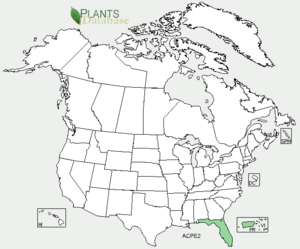Ray spiked fern facts for kids
Quick facts for kids Ray spiked fern |
|
|---|---|
| Scientific classification | |
| Genus: |
Actinostachys
|
| Species: |
pennula
|
Actinostachys pennula, also known as the ray spiked fern or tropical curly-grass, is a special type of fern. It mainly grows in Southern Florida and is an endangered plant species. This means it's very rare and needs our protection!
Contents
Where It Lives
The ray spiked fern lives in many parts of North and South America. You can find it in places like Florida in the United States, Southern Mexico, and countries in the Caribbean. It also grows in Brazil and other parts of South America. In Florida, it has been seen in Miami-Dade, Palm Beach, and Lee counties.
Its Home and How It Lives
Actinostachys pennula is a fern that grows on land. It loves tropical areas, which are warm and wet. You can often find this fern near old, rotting tree stumps and decaying leaves. It likes places in very wet rainforests and baylands, which are wetlands often touched by ocean tides.
This fern is a perennial plant, meaning it lives for more than two years. It usually grows at low elevations, from sea level up to about 500 feet high. The best places for it are wet, marshy areas with high temperatures and lots of sunlight. Ferns that get more sun tend to grow larger than those in shadier spots.
What It Looks Like
These ferns can be anywhere from 5 to 50 centimeters tall. Smaller ones might live among decaying leaves, while larger ones grow in open, sunny areas. It's not a grass, even though one of its nicknames is "tropical curly-grass."
The roots of the Actinostachys pennula are dark and covered with stiff, black hairs. These hairs make the rhizome, which is like the fern's underground stem, look hairy and bristly. Its main stems stand upright and have hairs in a single line.
What's interesting is that the stem isn't just one piece. It's made of many tiny, narrow stems, usually less than 1 millimeter wide. New stems grow quickly from the bases of old leaves. This makes the plant look more like a tightly packed, bushy plant than a single-stemmed one.
The leaves look like grass and can be from 1 to 60 millimeters long. All the leaves are fertile, meaning they can help the plant reproduce. They don't have branches and have long stalks called petioles. The blades of the leaves have "rays" that make them look like they are in a circular pattern. These rays can be different lengths. All new leaves grow from the base of older leaves. The many curly petioles give Actinostachys pennula its nickname, the tropical curly-grass plant.
How It Reproduces
The word "Stachys" means "spike," and it refers to the fertile parts of the Actinostachys pennula, which are shaped like a spike. When young Actinostachys pennula plants are growing, they have a large, bulging gametophyte attached. This part is left over after the plant matures. Sometimes, this large, bulb-like gametophyte is mistaken for the plant's stem.
Why It Needs Our Help
Actinostachys pennula is an endangered plant species. This means it's at high risk of disappearing forever. It's listed as endangered by the USDA and critically threatened by other groups.
One big threat comes from other ferns, like Lygodium japonicum and Lygodium microphyllum. These are invasive species, meaning they are not native to the area and can spread very quickly. They can take over an area and push out native plants like Actinostachys pennula. Studies show that these invasive ferns are a major danger to the ray spiked fern in Florida.
Wildfires also threaten the survival of Actinostachys pennula. It is thought that fewer than a thousand Actinostachys pennula plants exist in Boynton Beach, Florida, where the Loxahatchee National Wildlife Refuge is located. Protecting their habitat is very important to help these special ferns survive.


